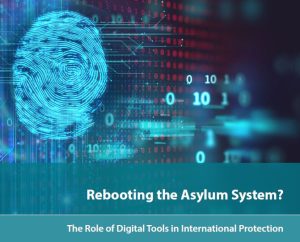Tech playing a larger role in asylum systems – report
Digital technology is playing a key role in reviving refugee and asylum programs in the wake of COVID-19 lockdowns, a new study has found.
The report, titled ‘Rebooting the Asylum System? The Role of Digital Tools in International Protection’, produced by the Washington-based think tank the Migration Policy Institute, says that digital technologies are also helping to re-imagine how they work with accelerating use during the identification and security check phases and greater reliance on mobile phone data and speech analysis software.
“Asylum authorities around the world have begun to see the potential of digitalization—i.e., the incorporation of digital tools and new technologies—to tackle long-standing problems in humanitarian protection systems, including limited staff and infrastructure to swiftly register and process protection claims and differential recognition rates stemming from human error and bias,” the report says.
“From chatbots that help asylum seekers register their protection claims and interviews conducted remotely via video, digital tools have permeated migration, asylum and border management systems,” it says.
“This is particularly the case in Europe, where the 2015–16 migration and refugee crisis jumpstarted a first round of digitalization. Yet many stakeholders remain concerned about using digital tools, worried about data privacy, opaque decision-making and the dehumanization of the process.”
 But the report also warns that technology is no universal cure, and depending on how such efforts are carried out, they could obstruct the asylum process and violate asylum seekers’ rights as easily as they could facilitate or protect them.
But the report also warns that technology is no universal cure, and depending on how such efforts are carried out, they could obstruct the asylum process and violate asylum seekers’ rights as easily as they could facilitate or protect them.
But “s growing list of benefits, such as speeding up processes, reducing arbitrariness in decision-making and making migration patterns more predictable, has persuaded more and more authorities to experiment with and invest in digitalisation efforts,” the report says.
“Realising the full potential of technology requires continuous setting of goals and standards, as well as consistent cost-benefit analysis and monitoring and evaluation of the impact of digital tools on asylum processes,” it says.
And the study identifies six key criteria through which the use of digital tools should be considered. They include whether they:
*Generate efficiency gains in workflows, staffing and infrastructure, speeding up processes and enhancing the capacity of authorities to deal with larger asylum caseloads;
*Reduce arbitrariness in decision-making, with artificial intelligence supporting broader efforts to reduce human error and bias, and thus improve the quality of and increase trust in asylum judgements;
*Facilitate improved communication between agencies and with asylum seekers through online communication tools.
*Improve migration and asylum intelligence, with early warning systems and forecasting and scenario-building exercises promising to give authorities greater insight into rapidly evolving or even future humanitarian migration trends.
*Enhance the confirmation of asylum seekers’ identities and eligibility for benefits while not becoming overtaken by security-related goals, such as the fight against terrorism, crime or fraud, and;
*Allow for remote operation of aspects of humanitarian protection systems.
“Injecting digital tools into asylum and migration systems has a profound effect on practices, procedures and a person’s chances of attaining protection, but there are limits to the role they can play in resolving these systems’ problems. For example, there are concerns that remotely operated asylum systems would pave the way for further erosion of the principle of territorial asylum,” the report says.
Read the full report here: www.migrationpolicy.org/research/asylum-system-digital-tools.












